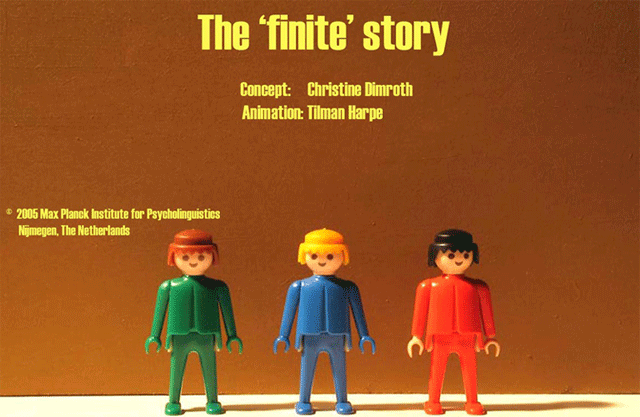Project description
The group focuses on the functioning of optional elements like negation markers and scope particles equivalent to also, only, even, etc., also known as 'focus particles' (König 1991), in learner varieties. These items have scope properties, i.e. they selectively affect different parts of the sentence they occur in, and consequently modify its meaning in a variable way (Dimroth & Klein 1996).
Contrary to negation, the study of (additive, restrictive, temporal) scope particles in learner varieties has only recently found considerable attention (cf. for example: Andorno 2000, 2005; Becker & Dietrich 1996, Benazzo 2000, 2003; Dimroth & Dittmar 1998, Watorek & Perdue 1999). Research shows that, as negation, some of these items appear very early, but the acquisition of their specific features in the target language represents a complex task for the L2 learner. The learner has to cope with: (a) a lexical problem (what is the function associated to a given particle?), as the available repertoire of particles and the relations covered by each individual item - additive, restrictive, scalar, temporal, modal - are language specific; and (b) a structural problem (which syntactic positions are available for a given particle? how is its semantic influence to be signaled?), as different means are used cross-linguistically in order to mark scope (word order, prosody, etc.).
The study of their acquisition highlights how the options for utterance integration and scope marking change with the ongoing grammaticalization of the utterance, and especially the emergence of a finite verb, which opens up new positions and new means for scope marking (cf. for ex. Perdue et al. 2002). Moreover some basic scope items function as precursors of finiteness in that they serve the expression of (positive or negative) assertion. In L1 and L2 acquisition, finiteness-marking on the verb has been observed to be delayed in utterances that contain the first attested particles, i.e. additive particles and negation (Giuliano 2003, Becker 2005, Dimroth 2002), while the integration of more complex scope items, like adverbs of temporal contrast for example, depends on the grammaticalization of the information they are to affect e.g. the relation between different time spans (Benazzo 2003). These results indicate that the acquisition of scope particles is in many ways closely related to the expression of finiteness.
Furthermore, scope particles interact with discourse properties, i.e. the affected constituent depends on the referential movement (i.e. how reference to entities, times and places is established, maintained or changed throughout a narration). Additive particles, for example, can qualify anaphoric relations in these domains and thus enhance discourse cohesion. The comparison of L1 and L2 learners highlights how the acquisition of these items is affected by previous knowledge: the adult L2 learner already masters the discursive anaphoric function of particles but has to acquire their TL placement and scope marking, while the problem for the child is the anaphoric relations themselves: additive particles like aussi / auch are first used to link extra linguistic referents, before being used endophorically as a means to reinforce text cohesion (Nederstigt 2003, Watorek ed. 2004).
The group further investigates the acquisition of scope particles, in relation both to finiteness and the information structure of utterances in connected discourse, with respect to the following topics:
- Utterance integration and scope marking
- Which means are available to the learner in order to mark the semantic influence of scope particles at different acquisitional stages ?
- To what extent does intonation contribute to scope marking?
- Is the grammatical expression of finiteness a pre-requisite for the grammaticalization of scope properties?
- Discourse function :
- what is the contribution of scope particles in relation to the expression of finiteness (assertive and temporal value)?
- in which informational contexts do scope particles appear?
- what is their role with respect to discourse cohesion?
The group members will develop the comparative approach through the study of :
- children's L1 vs. adult L2 use of scope particles
- the acquisition of scope particles in different languages.
To this end, narrative production (new cross-linguistic) data are being collected with the help of a video-clip (“finite story”, MPI, 2005), designed to elicit a range of ‘qualified’ assertions (contrastive, additive, continuative, negative, etc.), in controlled contexts. which enable a more systematic comparison on the acquisition and native use of scope particles in Germanic, Romance and Slavic languages. The target languages under investigation by now include German, Dutch, French, Italian and Polish.
(i)
in the availability of other means for the expression of qualified
assertions (in contrast to German, French and Italian use preriphrastic
constructions like ‘continuer à Vlex/continuare a
Vlex’ in addition to the adverbials toujours/ancora);
(ii)
in the use of intonation for disambiguating information structure (e.g.
stressed vs. unstressed auch/ook in German and Dutch)
(iii)
in the preferred topic domain in relation to which assertions are
typically qualified in that way (if there is a choice, French tends to
mark that a similar assertion holds for a different temporal interval
whereas German and Italian tend to mark that a similar assertion holds
for a different entity).
The aim is to find out how second language learners of different languages acquire the relevant means for the expression of information structure and if they also acquire the more subtle language specific preferences and their consequences for discourse construction.
